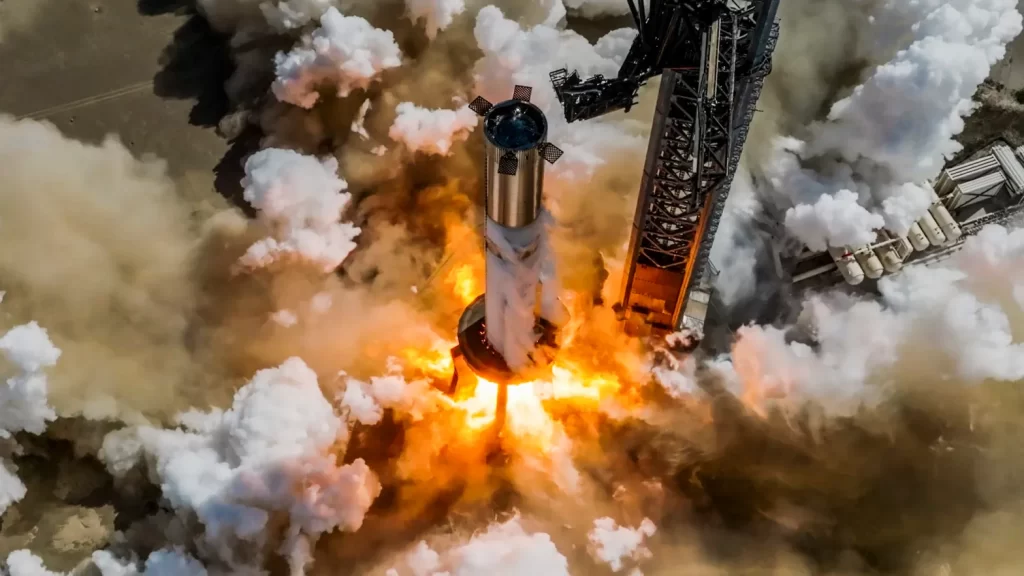
WASHINGTON — SpaceX could attempt to land a Starship booster as soon as the vehicle’s fifth flight as Elon Musk outlined plans to increase both the flight rate and the performance of the launch vehicle.
SpaceX posted on social media April 6 the video of an undated, but apparently recent, presentation the company’s founder and chief executive gave at its Starbase facility at Boca Chica, Texas. The presentation focused on the Starship vehicle built and launched there.
Musk said that the fourth Starship/Super Heavy launch is planned “in about a month or so.” That is consistent with comments by SpaceX President Gwynne Shotwell at the Satellite 2024 conference March 19, where she said that flight was scheduled for early May, pending an updated Federal Aviation Administration launch license. If the company holds to that schedule, the launch would take place less than two months after the vehicle’s third flight.
The goal of the fourth flight is for the Starship upper stage to get through the “high heating regime” of reentry and make a “controlled splat” into the ocean, he said. On the third flight, Starship broke up during reentry.
Musk said SpaceX also wants to bring the Super Heavy booster back intact on the next flight, having it land “on essentially a virtual tower” in the Gulf of Mexico. That would allow the company to proceed with an attempt to bring the booster back to Starbase for a landing.
“If the landing on the virtual tower works, then we will actually try on Flight 5 to come back and land on the tower,” he said. “That is very much a success-oriented schedule, but it is in the realm of possibility.”
Musk said he was optimistic that SpaceX would be able this year to land a booster back on the tower, using a pair of giant arms dubbed “Mechazilla” to cradle the booster. “The odds of us actually being able to catch the booster with the Mechazilla arms this year,” he said, “is probably 80 to 90%.”
Recovering the Starship upper stage, or ship, will take longer. Musk said he wanted to have at least two consecutive successful controlled splashdowns of Starship in the ocean before attempting a landing at Starbase. “We do not want to rain debris over Mexico or the U.S.,” he said. “My guess is probably next year when we will be able to reuse Starship.”
SpaceX is working to accelerate production of Starship vehicles to support higher flight rates. Before the March launch, company officials said they had four pairs of ships and boosters at Starbase for upcoming launches. Musk said in the presentation the company would build “roughly six” more vehicles this year.
“That production rate will increase a lot next year. That’s why we’re building the giant factory” planned for Starbase, he said.
He noted that, along with the increased production of Starship vehicles, the company was building a second launch tower at Starbase and expected to have its first launch tower at Cape Canaveral, Florida, operational by the middle of next year. “What we should probably expect is that we do the development launches here, test anything new here, build the rockets,” he said at Starbase, “and then probably most of the operational launches would be from the Cape.”
With the increased production rate will come increased payload capacity. Musk outlined improvements to the Raptor engine that will increase its thrust from 230 to 280 metric tons-force, and “ultimately” to more than 330 metric tons-force of thrust.
The engine improvements would support a “Starship 2” that also features a slightly longer booster and ship. That will be able to place more than 100 metric tons into orbit in a fully reusable configuration, Musk said. A future “Starship 3,” about 25 meters taller than Starship 2, would be able to place more than 200 metric tons into orbit in a fully reusable mode. He did not disclose when either Starship version would enter service.
Musk claimed that the future Starship 3 would cost less to launch than SpaceX’s original rocket, the Falcon 1 small launch vehicle, which had a price of about $10 million, because of full reusability. He estimated the Starship cost per launch could fall to as low as $2 million to $3 million.
“These are sort of unthinkable numbers,” he said. “Nobody ever thought this was possible. But we’re not breaking any physics to achieve this.”
























